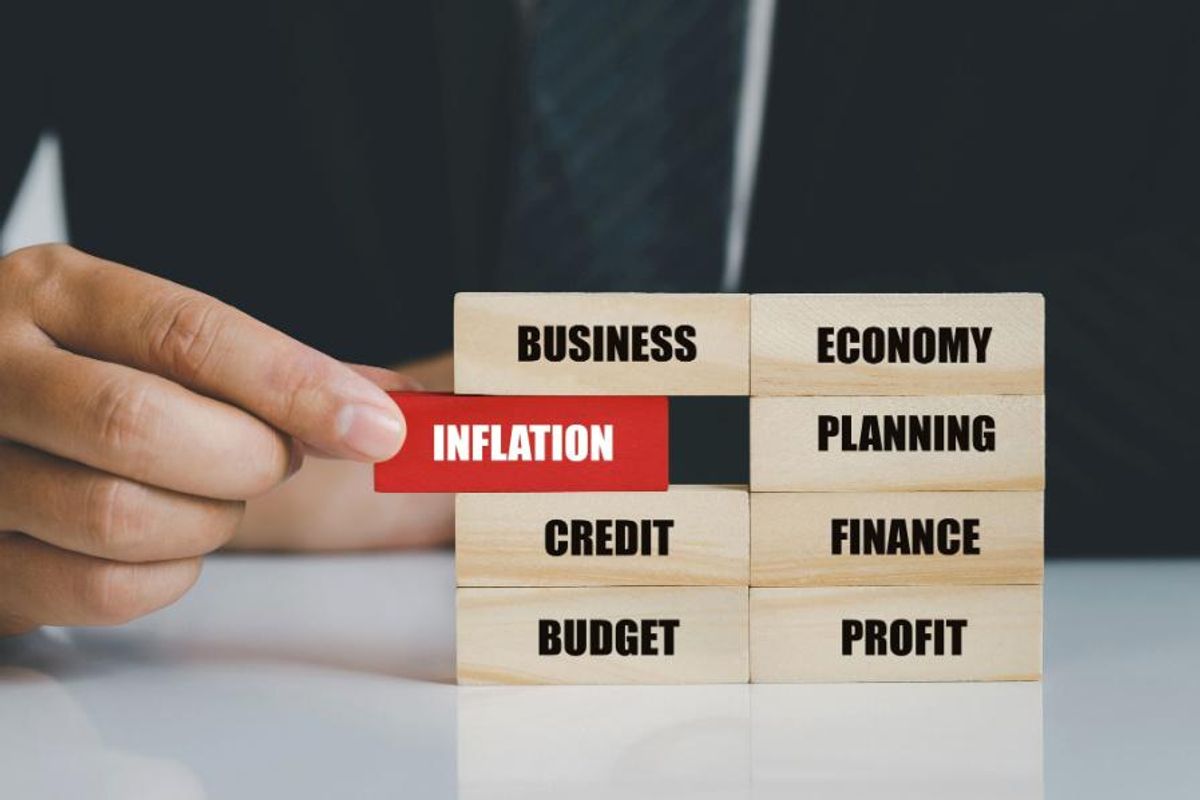Miners, Explorers Weigh in on Inflation Impact and Strategies to Fight It
Although most commodities prices remain somewhat elevated, investor sentiment has waned as costs rise for mining companies across the board.

Chayanuphol / Shutterstock
The post-pandemic recovery was severely hampered earlier this year when Russia invaded Ukraine, impeding global economic growth and obstructing supply chains across the world.
The conflict also drove up inflation, which was already high and is now reaching 40 year peaks in many parts of the world, leaving central banks trying to simultaneously spur economic growth and quash elevated prices.
With interest rate hikes in play and the US putting in two consecutive quarters of negative GDP growth (typically seen as a recession), discussions about stagflation have begun to circulate. Stagflation is defined as an economic period where inflation is high, economic growth is slow and unemployment is elevated.
“Such an unfavorable combination is feared and can be a dilemma for governments since most actions designed to lower inflation may raise unemployment levels, and policies designed to decrease unemployment may worsen inflation,” explains the Corporate Finance Institute, an online platform for training and education.
One school of thought links stagflation to supply shocks, whether it be a sudden increase or decrease in supply for a commodity or service. A second theory on what causes stagflation involves poor economic policy.
In June, the World Bank released its Global Economic Prospects report, which highlights the mounting risk of stagflation. Punctuated by broad uncertainty, global economic growth is seen contracting to 2.9 percent from last year’s 5.7 percent; this is a revised projection from January, when 2022 growth was pegged at 4.1 percent.
“The war in Ukraine, lockdowns in China, supply-chain disruptions, and the risk of stagflation are hammering growth. For many countries, recession will be hard to avoid,” World Bank President David Malpass said. “Markets look forward, so it is urgent to encourage production and avoid trade restrictions. Changes in fiscal, monetary, climate and debt policy are needed to counter capital misallocation and inequality.”
Volatility has weighed heavily on North American markets, which have all registered negative moves for the first eight months of 2022. Most affected thus far have been the NASDAQ Composite (INDEXNASDAQ:.IXIC), which shed 24 percent from January through August, and Canada’s junior exchange, the S&P/TSX Venture Composite Index (INDEXTSI:JX), which contracted by 31.12 percent over the same period.
Although most commodities prices remain relatively high, the strong investor sentiment that buoyed companies in the sector in 2020 and 2021 has waned as the cost of seemingly everything rises.
At this year’s Rule Symposium, held at the end of July, the Investing News Network (INN) spoke with several companies about the current state of the market and investor disposition. Here's what they said.
Junior miners make adjustments in face of inflation
Gold, which traded for US$1,530 per ounce in January 2020 before passing the US$2,000 level that August, broke that threshold again this year. It hit its highest price ever on March 8, but a strong US dollar pushed the yellow metal lower from April through July, when values tumbled to US$1,694, an 18 month low.
“I think in the past six months, our industry has been kind of in a downturn,” Chris Curran, head of corporate development and communications at Tudor Gold (TSXV:TUD.V), told INN on the sidelines of the Rule Symposium. “It’s been quieter than it has been the last couple years, definitely.”
Speaking just after the last interest rate hike from the US Federal Reserve, Curran said that perhaps the move would mark a change in investor sentiment. “I'm hoping that's going to be a turnaround right here,” he said.
Tudor's flagship asset is the Treaty Creek gold project in BC's Golden Triangle region. “We've got high leverage to the gold price,” he said. “With an increasing gold price, that will really help us attract investor interest and get them interested again, especially in companies such as ours (with) large gold deposits.”
While remaining optimistic, Curran did note that inflation is driving up the cost of services, which is a concern for both his company and the broader mining sector.
“(Inflation) hasn't really changed our outlook on advancing our project, (but) we're doing some things differently to save costs,” he said. “All our costs have gone up — gas, labor, helicopter costs — so we're being more cautious.”
In late August, Tudor released its fifth set of drill results from a Phase l exploration program at Treaty Creek. The announcement highlights “two high-grade precious metal intercepts” at the Goldstorm deposit.
In addition to the ongoing exploration program at Treaty Creek, Curran told INN about the company’s plans for the Crown property, located in the same district as Treaty Creek.
“We're actually spinning off one of our properties, Crown, which we own 100 percent of,” he said. “So if you're a Tudor Gold shareholder, for every four shares you hold of Tudor Gold, you get one (share) of the new company.”
First Majestic's Keith Neumeyer on offsetting rising costs
Concerns around how inflation is impacting mining companies' bottom lines were also raised by Keith Neumeyer, president and CEO of First Majestic Silver (TSX:FR,NYSE:AG), who noted in a Rule Symposium presentation that the firm has had to make some adjustments in the wake of today's economic conditions.
“There are some inflationary pressures to be sure. On the business side, we've seen energy costs — in Nevada, for example — go up 50 percent in the last six months. Pretty shocking,” he said at the event.
In order to offset rising energy costs, as well as costs for key materials like cyanide, ammonia and lubricants, Neumeyer explained that the silver company has looked to make cost reductions elsewhere.
“We actually reduced our budget this year,” he said, noting an 8 percent inflation rate across the business. “We also cut the budget on top of that.”
At the same time, the company's 2022 production has increased out of Mexico, allowing First Majestic to remain within its production targets. A Q2 update notes that its guidance for the year now stands at 32.5 million to 34.6 million silver equivalent ounces versus prior guidance of 32.2 million to 35.8 million silver equivalent ounces.
Uranium outlook positive, but costs still rising
It's not just oil and gas that have seen price growth as the world grapples with the need for energy and broad environmental goals. Uranium has made major gains since 2020, rising 99 percent from January of that year to the end of August this year; earlier in 2022, it even briefly passed US$65 per pound for the first time since 2011.
Even so, uranium explorers have also had to navigate inflation, geopolitical unrest and supply chain challenges.
As Ross McElroy, Fission Uranium’s (TSX:FCU,OTCQX:FCUUF) CEO, president and director, explained, the sector had been plagued by persistently low prices before 2020’s price spike.
“Everybody knows that uranium prices were well, well, well below incentive prices for probably a decade after Fukushima,” he said. McElroy went on to explain that over the last two years the incentive price, the amount needed to bring new production online and drive more exploration, is no longer US$50.
“I think the real incentive number these days is probably US$70 to US$80, and maybe that's also borne in with inflation too, right. You know, inflation does increase that," he said.
Even though uranium remains below that US$70 to US$80 incentive threshold, the sector has been getting more attention than some parts of the resource arena, and McElroy noted that he's been happy to see this increased interest as nuclear becomes an increasingly prevalent part of the clean energy transition.
“The same overall excitement in the sector is reflected in interest in Fission and our share price,” McElroy said.
Heightened investor interest has helped facilitate the advancement of the company’s PLS project, located in Saskatchewan's Athabasca Basin. Fission is currently working on the feasibility study for the asset.
“I think there's a lot more investor enthusiasm,” he said. “You really do get a sense of the sea change out there.”
Don't forget to follow us @INN_Resource for real-time updates!
Securities Disclosure: I, Georgia Williams, hold no direct investment interest in any company mentioned in this article.
Editorial Disclosure: The Investing News Network does not guarantee the accuracy or thoroughness of the information reported in the interviews it conducts. The opinions expressed in these interviews do not reflect the opinions of the Investing News Network and do not constitute investment advice. All readers are encouraged to perform their own due diligence.
- Experts: Gold is the Answer to Today's Troubling Questions ›
- Silver Outlook 2022: Supply/Demand Trends Could Catalyze Price ›
- Gold Outlook 2022: Consolidation a Launching Pad for Price Rise ›





